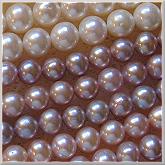Because pearls are natural organic substances, they can occur in a wide variety of shapes, many of which are quite unique and interesting. The round pearls you most commonly see are by no means the only shape in which pearls are found!
Indeed, perfectly round pearls are actually quite rare. This is because the eventual shape of the pearl is determined by a number of highly variable factors which occur inside the oyster as the pearl is developing. For example, the pearl often assumes the same shape as its nucleus (the irritant which was placed inside the oyster to initiate the formation of the pearl). If the nucleus is not perfectly round, the resulting pearl is likely to reflect this irregularity. In addition, the pearl's positioning within the oyster also plays a role in determining its shape. If the pearl develops against the shell, for example, it will become more flattened on that side.
Pearl experts generally divide pearl shapes into three broad categories, based on their overall characteristics:

Round pearls are perfectly spherical -- Round pearls are rarely perfect spheres unless they are of gem quality or imitation. The longer the pearl remains within the oyster or mussel, the more chance there is of it developing a different shape. Contrary to the images portrayed in films very large round pearls are uncommon - and very expensive. Even seawater pearls, which have a round shell bead as their nucleus, have a hard time keeping their shape as they grow. Increasing the size of bead increases the mortality rate of the oyster. Many of the largest, most beautiful pearls come from the South Seas

The term off-round is used to describe pearls which are 'roundish' to the eye but have a slightly oval or flattened shape. They can still have excellent qualities in terms of lustre or lack of blemish but being off-round makes them less expensive. Before the cultured pearl industry began in the early 1900's most natural wild pearls were off-round or baroque (a general term for an irregular shape). Off round pearls can provide excellent value for money.

Oval pearls are sometimes also known as rice pearls although this is a slightly misleading term. It comes from the early days of Chinese freshwater pearl production when large numbers of low quality pearls came onto the market and were derided as 'rice-crispies' after the cereal. Today, Chinese freshwater pearls can compete in quality with the world's best. Oval pearls come in a variety of sizes and colours. Sometimes they are formed when two pearls growing close to one another in the same mollusc join together.

Many of these are button pearls, so-called because of their distinctive shape - round on one side and flat on the other. Button pearls are flattened to some degree, making them resemble a button or perhaps a disk rather than a perfect sphere. These pearls are often used in earrings, where the flattened side can be attached to the setting. Buttons are also categorized as symmetrical.
The term 'Biwa' derives from Lake Biwa - a large freshwater lake near Kyoto in Japan. This was once the focus of the Japanese freshwater pearl industry. In the 1980's pearl production there virtually ceased due to industrial pollution. Biwa became a generic name for all freshwater pearls regardless of their shape. Technically it is incorrect to call pearls Biwa pearls (like French fries or English muffins) unless they actually come from Lake Biwa. We use the term simply to identify the unique shape of these particular pearls.
Cnepearls.com online jewelry store wholesale pearl strands& bead:Nugget freshwater pearls, Coin pearl strands; firecracker pearl;Blister pearls; Biwa /stick pearls; Seed pearl beads
